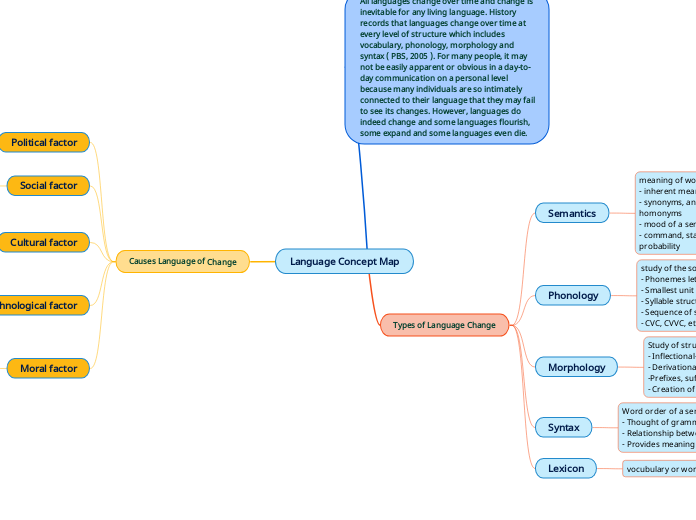Language Concept Map
All languages change over time and change is inevitable for any living language. History records that languages change over time at every level of structure which includes
vocabulary, phonology, morphology and syntax ( PBS, 2005 ). For many people, it may not be easily apparent or obvious in a day-to-day communication on a personal level because many individuals are so intimately connected to their language that they may fail to see its changes. However, languages do indeed change and some languages flourish, some expand and some languages even die.
Types of Language Change
Semantics
meaning of words, phrases, and sentences
- inherent meanings of words
- synonyms, antonyms, homophones, homonyms
- mood of a sentence
- command, statement, permission, probability
Phonology
study of the sounds in a langauge
- Phonemes letters create
- Smallest unit of sound
- Syllable structure
- Sequence of sounds
- CVC, CVVC, etc.
Morphology
Study of structure of words
- Inflectional- Number, tense, & degree
- Derivational
-Prefixes, suffixes, lexical category
- Creation of new words
Syntax
Word order of a sentence
- Thought of grammar
- Relationship between words
- Provides meaning and understanding
Lexicon
vocubulary or words of a language
Causes Language of Change
Political factor
Which is caused by foreign invasion, migration and colonization.
Social factor
which means foreign influences from Latin, French, American, Australian, Indian, and others.
Cultural factor
This means the exposure of one language group to another via television, radio, films, music, magazines and fashion.
Technological factor
Means rapid advances in information technology, industries, products and economy simply require new words that drive language change.
Moral factor
Means rapid advances in information technology, industries, products and economy simply require new words that drive langauge change.
